Regulation of vascular nitric oxide in vitro and in vivo; a new role for endogenous hydrogen sulphide?
- PMID: 17016507
- PMCID: PMC2014646
- DOI: 10.1038/sj.bjp.0706906
Regulation of vascular nitric oxide in vitro and in vivo; a new role for endogenous hydrogen sulphide?
Abstract
Background and purpose: The aim of these experiments was to evaluate the significance of the chemical reaction between hydrogen sulphide (H2S) and nitric oxide (NO) for the control of vascular tone.
Experimental approach: The effect of sodium hydrosulphide (NaHS; H2S donor) and a range of NO donors, such as sodium nitroprusside (SNP), either alone or together, was determined using phenylephrine (PE)-precontracted rat aortic rings and on the blood pressure of anaesthetised rats.
Key results: Mixing NaHS with NO donors inhibited the vasorelaxant effect of NO both in vitro and in vivo. Low concentrations of NaHS or H2S gas in solution reversed the relaxant effect of acetylcholine (ACh, 400 nM) and histamine (100 microM) but not isoprenaline (400 nM). The effect of NaHS on the ACh response was antagonized by CuSO(4) (200 nM) but was unaffected by glibenclamide (10 microM). In contrast, high concentrations of NaHS (200-1600 microM) relaxed aortic rings directly, an effect reduced by glibenclamide but unaffected by CuSO4. Intravenous infusion of a low concentration of NaHS (10 micromol kg(-1) min(-1)) into the anaesthetized rat significantly increased mean arterial blood pressure. L-NAME (25 mg kg(-1), i.v.) pretreatment reduced this effect.
Conclusions and implications: These results suggest that H2S and NO react together to form a molecule (possibly a nitrosothiol) which exhibits little or no vasorelaxant activity either in vitro or in vivo. We propose that a crucial, and hitherto unappreciated, role of H2S in the vascular system is the regulation of the availability of NO.
Figures
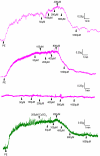
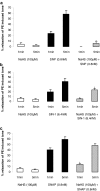
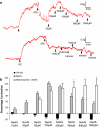
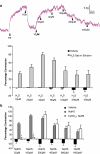
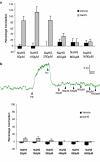
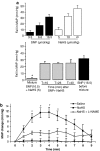
Comment in
-
What is the significance of vascular hydrogen sulphide (H2S)?Br J Pharmacol. 2006 Nov;149(6):609-10. doi: 10.1038/sj.bjp.0706907. Epub 2006 Oct 3. Br J Pharmacol. 2006. PMID: 17016506 Free PMC article.
Similar articles
-
Evidence for the formation of a novel nitrosothiol from the gaseous mediators nitric oxide and hydrogen sulphide.Biochem Biophys Res Commun. 2006 Apr 28;343(1):303-10. doi: 10.1016/j.bbrc.2006.02.154. Epub 2006 Mar 6. Biochem Biophys Res Commun. 2006. PMID: 16540095
-
Effects of nitric oxide and hydrogen sulfide on the relaxation of pulmonary arteries in rats.Chin Med J (Engl). 2008 Mar 5;121(5):420-3. Chin Med J (Engl). 2008. PMID: 18364114
-
Interaction between hydrogen sulfide and nitric oxide on cardiac protection in rats with metabolic syndrome.Zhongguo Yi Xue Ke Xue Yuan Xue Bao. 2011 Feb;33(1):25-32. doi: 10.3881/j.issn.1000-503X.2011.01.007. Zhongguo Yi Xue Ke Xue Yuan Xue Bao. 2011. PMID: 21375934
-
Hydrogen sulphide and the hyperdynamic circulation in cirrhosis: a hypothesis.Gut. 2005 Dec;54(12):1668-71. doi: 10.1136/gut.2004.056556. Epub 2005 Sep 20. Gut. 2005. PMID: 16174660 Free PMC article. Review.
-
The role of hydrogen sulphide in blood pressure regulation.Physiol Res. 2016 Oct 24;65(Suppl 3):S273-S289. doi: 10.33549/physiolres.933438. Physiol Res. 2016. PMID: 27775417 Review.
Cited by
-
Hydrogen sulfide: A new therapeutic target in vascular diseases.Front Endocrinol (Lausanne). 2022 Aug 10;13:934231. doi: 10.3389/fendo.2022.934231. eCollection 2022. Front Endocrinol (Lausanne). 2022. PMID: 36034427 Free PMC article. Review.
-
Analysis of cardiovascular responses to the H2S donors Na2S and NaHS in the rat.Am J Physiol Heart Circ Physiol. 2015 Aug 15;309(4):H605-14. doi: 10.1152/ajpheart.00171.2015. Epub 2015 Jun 12. Am J Physiol Heart Circ Physiol. 2015. PMID: 26071540 Free PMC article.
-
17O NMR spectroscopy-assisted in vitro bioactivity studies of the intermediates formed via Na2S and RSNO cross-linking reactions.RSC Adv. 2020 Oct 29;10(65):39617-39626. doi: 10.1039/d0ra05054g. eCollection 2020 Oct 27. RSC Adv. 2020. PMID: 35515380 Free PMC article.
-
Hydrogen Sulfide Biochemistry and Interplay with Other Gaseous Mediators in Mammalian Physiology.Oxid Med Cell Longev. 2018 Jun 27;2018:6290931. doi: 10.1155/2018/6290931. eCollection 2018. Oxid Med Cell Longev. 2018. PMID: 30050658 Free PMC article. Review.
-
Hydrogen sulfide attenuates sFlt1-induced hypertension and renal damage by upregulating vascular endothelial growth factor.J Am Soc Nephrol. 2014 Apr;25(4):717-25. doi: 10.1681/ASN.2013030291. Epub 2013 Dec 12. J Am Soc Nephrol. 2014. PMID: 24335973 Free PMC article.
References
-
- Dombkowski RA, Russell MJ, Olson KR. Hydrogen sulfide as an endogenous regulator of vascular smooth muscle tone in trout. Am J Physiol. 2004;286:R678–R685. - PubMed
-
- Golpon HA, Puchner A, Barth P, Welte T, Wichert P, Feddersen CO. Nitric oxide-dependent vasorelaxation and endothelial cell damage caused by mercury chloride. Toxicology. 2003;192:179–188. - PubMed
Publication types
MeSH terms
Substances
LinkOut - more resources
Full Text Sources
Other Literature Sources
Miscellaneous

